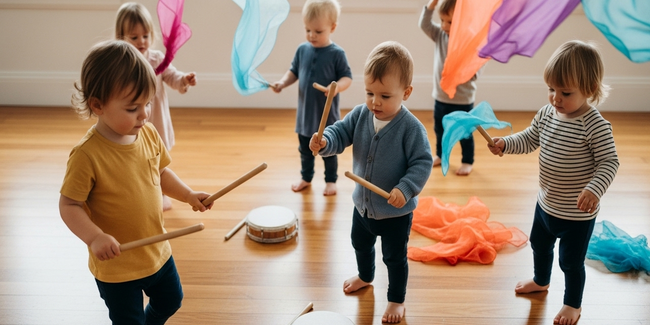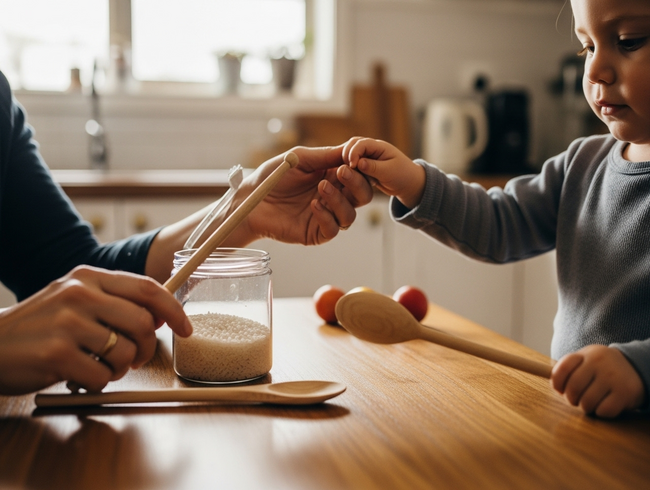Have you ever watched a toddler’s face light up when their favorite song comes on? That spontaneous dancing and giggling isn’t just adorable – it’s actually building their brain in remarkable ways. Music and movement activities for toddlers create powerful learning experiences that strengthen neural pathways, enhance motor skills, and support emotional development during the most critical period of brain growth.
At Okinja Early Learning Centre on the Sunshine Coast, we’ve witnessed firsthand how purposeful music and movement experiences transform young learners. Our approach combines the latest research in early childhood brain development with practical, joy-filled activities that parents and educators can easily implement.
The Brain Under Construction: The Neuroscience of Music and Movement
During the toddler years (ages 1-3), a child’s brain forms over 1 million neural connections every second. Music and movement activities act as powerful catalysts in this process, simultaneously engaging multiple brain regions and creating robust neural networks that support lifelong learning.
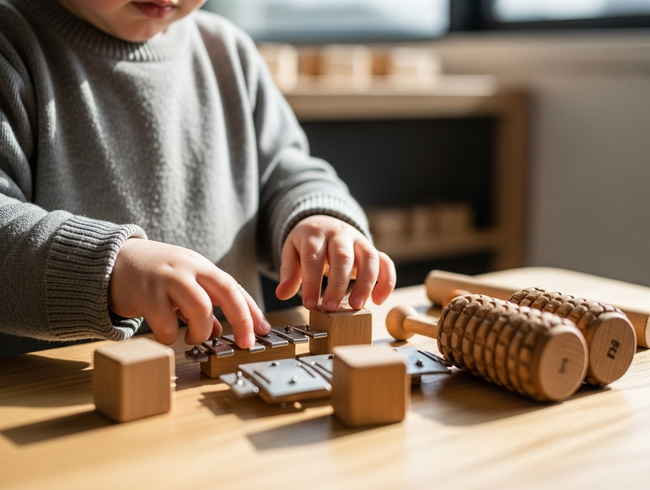
When toddlers engage in music and movement, their brains activate areas responsible for:
- Motor Planning and Coordination: Dancing and rhythmic movements strengthen the cerebellum and motor cortex
- Language Development: Musical patterns mirror speech rhythms, supporting vocabulary and communication skills
- Emotional Regulation: Music activates the limbic system, helping children process and express emotions
- Memory Consolidation: Rhythmic patterns enhance memory formation and recall abilities
- Social Connection: Group musical activities develop empathy and social awareness
Research from the University of Southern California shows that children who participate in music programs demonstrate accelerated brain development, particularly in areas associated with language acquisition and reading readiness.
15 Brain-Building Music and Movement Activities
These carefully selected activities are designed to support different aspects of toddler development while bringing joy and connection to daily routines.
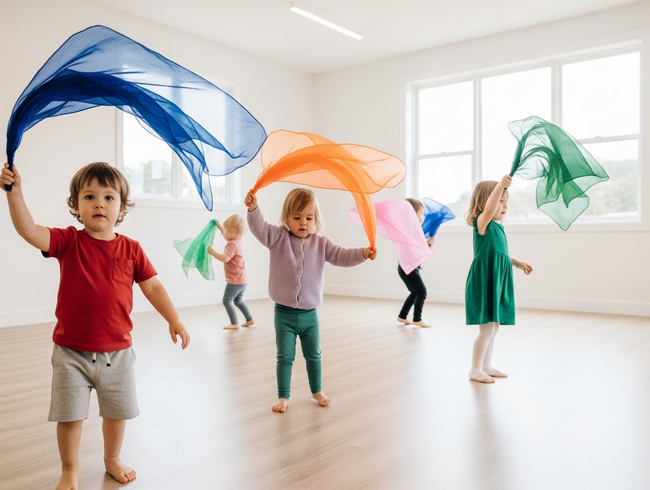
1. Rainbow Scarf Dancing
Age: 12+ months
Materials: Colourful silk scarves or lightweight fabric squares
Development Focus: Gross motor skills, spatial awareness, creative expression
Put on instrumental music with varying tempos and encourage toddlers to move their scarves through the air. Demonstrate different movements: swirling overhead, floating gently, or waving from side to side. This activity develops bilateral coordination as children use both arms in synchronised movements while tracking the scarf’s path develops visual-spatial skills.
2. Freeze Dance with Emotions
Age: 18+ months
Materials: Upbeat music with clear stop/start capability
Development Focus: Self-regulation, emotional recognition, gross motor control
Play music and encourage dancing, then pause unexpectedly. When the music stops, call out different emotions (“freeze like you’re happy!” or “freeze like you’re sleepy!”). This activity builds executive function skills as children must quickly shift between movement and stillness while practising emotional expression and recognition.
3. Rhythm Stick Symphony
Age: 15+ months
Materials: Wooden rhythm sticks or wooden spoons
Development Focus: Fine motor skills, auditory processing, pattern recognition
Start with simple patterns like tap-tap-pause, then gradually increase complexity. Encourage toddlers to copy your rhythms or create their own. This activity strengthens hand-eye coordination and introduces mathematical concepts through pattern recognition while developing auditory discrimination skills.
4. Animal Movement Songs
Age: 12+ months
Materials: None needed
Development Focus: Gross motor variety, imaginative play, language development
Sing songs that incorporate different animal movements: “We can stomp like elephants,” “We can hop like bunnies,” or “We can slither like snakes.” This activity develops motor planning as children must coordinate different movement patterns while expanding vocabulary and encouraging imaginative thinking.
5. Musical Obstacle Course
Age: 18+ months
Materials: Cushions, tunnels, or simple obstacles; portable music player
Development Focus: Gross motor skills, spatial planning, problem-solving
Set up a simple course with pillows to step over, tunnels to crawl through, or lines to follow. Play different types of music to inspire different movements – marching music for stepping, flowing music for crawling. This integrates physical challenges with musical response, developing motor planning and spatial awareness.
6. Bubble Pop Dancing
Age: 12+ months
Materials: Bubble solution and wand, soft background music
Development Focus: Hand-eye coordination, spatial tracking, gross motor skills
Blow bubbles while playing gentle music, encouraging toddlers to dance and pop bubbles simultaneously. This activity requires complex coordination as children must track moving targets while controlling their body movements, developing visual-motor integration skills.
7. Sound Exploration Station
Age: 10+ months
Materials: Safe household items: wooden spoons, metal bowls, containers with beans
Development Focus: Auditory discrimination, cause-and-effect understanding, fine motor skills
Create a collection of safe sound-making materials and let toddlers explore the different tones and volumes they can create. Encourage gentle exploration and model different ways to create sounds. This develops auditory processing skills and introduces concepts of pitch, volume, and timbre.
Simple home musical activities strengthen the parent-child bond while extending professional early learning experiences.
8. Parachute Play
Age: 15+ months
Materials: Large lightweight fabric or small parachute
Development Focus: Cooperative play, gross motor skills, sensory integration
Hold the edges of the fabric with the toddler and move it up and down to music, creating waves and watching toys bounce on top. This activity develops bilateral coordination, cooperation skills, and provides vestibular input that supports sensory integration.
9. Echo Clapping
Age: 12+ months
Materials: None needed
Development Focus: Auditory memory, imitation skills, bilateral coordination
Start with simple clapping patterns and have toddlers copy you. Begin with two claps, then gradually increase complexity. This develops working memory as children must hold the pattern in mind while executing the movements, strengthening neural pathways essential for later academic learning.
10. Sensory Music Box
Age: 12+ months
Materials: Box with various textured items, soft music
Development Focus: Sensory processing, fine motor exploration, concentration
Fill a box with items of different textures (soft fabric, smooth stones, rough sandpaper squares) and play soft music while toddlers explore. This activity develops tactile discrimination while the music creates a calm, focused environment for sensory exploration.
11. Follow the Leader Musical March
Age: 18+ months
Materials: Marching music
Development Focus: Social skills, gross motor coordination, attention and following directions
Lead toddlers around the space with different marching styles – high steps, tiptoeing, giant steps. This develops social imitation skills, gross motor variety, and attention to instruction while building leg strength and coordination.
12. Singing Bowl Meditation
Age: 15+ months
Materials: Singing bowl or bell, soft mat
Development Focus: Emotional regulation, auditory processing, mindfulness introduction
Ring a singing bowl and encourage toddlers to listen until they can no longer hear the sound, then gently move their bodies to represent what they heard. This develops sustained attention, auditory discrimination, and introduces early mindfulness concepts that support emotional regulation.
13. Colour Dance
Age: 18+ months
Materials: Coloured scarves or ribbons, varied music
Development Focus: Colour recognition, creative expression, gross motor skills
Give each toddler a different coloured scarf and play various types of music, calling out colours for specific movements. “All red scarves dance high!” or “Blue scarves spin around!” This integrates colour learning with movement and develops selective attention skills.
14. Musical Story Acting
Age: 20+ months
Materials: Simple story with actions, background music
Development Focus: Language comprehension, imaginative play, sequence understanding
Tell a simple story with repeated actions set to music – perhaps about a bunny hopping through a garden or a bird flying through the sky. This develops narrative understanding, sequence memory, and integrates language learning with physical expression.
15. Heartbeat Drums
Age: 12+ months
Materials: Hand drums or upturned pots, soft mallets
Development Focus: Rhythm recognition, bilateral coordination, self-soothing
Start by having toddlers feel their heartbeat, then drum at that steady rhythm. Vary the tempo slowly and encourage toddlers to match different rhythms. This develops internal rhythm awareness, bilateral coordination, and provides a calming, organising sensory experience.
Addressing Common Challenges in Music and Movement
Even the most well-planned activities can present challenges. Here’s how to navigate common situations with patience and creativity:
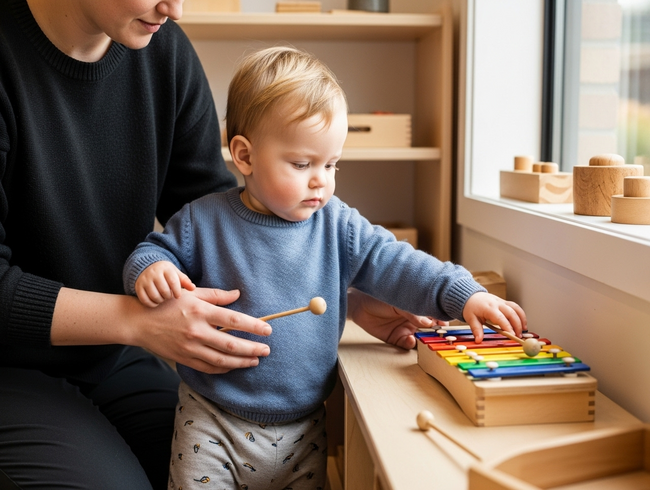
The Hesitant Observer
Some toddlers prefer to watch before joining. This is developmentally appropriate and should be respected. Offer gentle invitations without pressure: “Would you like to hold a scarf and watch?” or “You can dance from right here if you’d like.” Often, hesitant children become enthusiastic participants once they feel safe and ready.
Overstimulation and Meltdowns
Music and movement can be overwhelming for sensitive children. Create quiet retreat spaces, offer calmer musical options, and watch for signs of overstimulation: covering ears, turning away, or becoming agitated. Having a calm-down corner with soft music can help children regulate when needed.
Short Attention Spans
Toddler attention spans average 2-6 minutes. Keep activities brief and be ready to transition quickly. Having multiple short activities works better than one long session. Follow the child’s lead and be flexible with timing.
Different Developmental Stages
In mixed-age groups, adapt activities to include all levels. Offer variations: “Older friends can hop on one foot, younger friends can march in place.” This creates inclusive experiences where every child can participate successfully.
Creating the Optimal Environment for Music and Movement
The physical and emotional environment significantly impacts the success of music and movement activities. Consider these elements:
Physical Space Considerations
- Safety First: Ensure adequate space for movement with soft surfaces and cleared pathways
- Sound Quality: Use speakers that produce clear, not overly loud music
- Natural Elements: Incorporate natural materials and outdoor spaces when possible
- Flexibility: Arrange furniture that can be easily moved to create dance space
Emotional Environment
- Joy-Focused: Prioritise fun and connection over perfect execution
- Inclusive: Welcome all forms of participation, including watching or modified participation
- Patient: Allow time for skill development without rushing or pressuring
- Celebrating: Acknowledge effort and creativity rather than focusing on outcomes
The Okinja Approach: Music, Movement, and Natural Learning
At Okinja Early Learning Centre, we believe that music and movement experiences should connect children with both their inner creativity and the natural world around them. Our approach integrates these activities seamlessly throughout the day, both indoors and in our four unique outdoor learning environments.
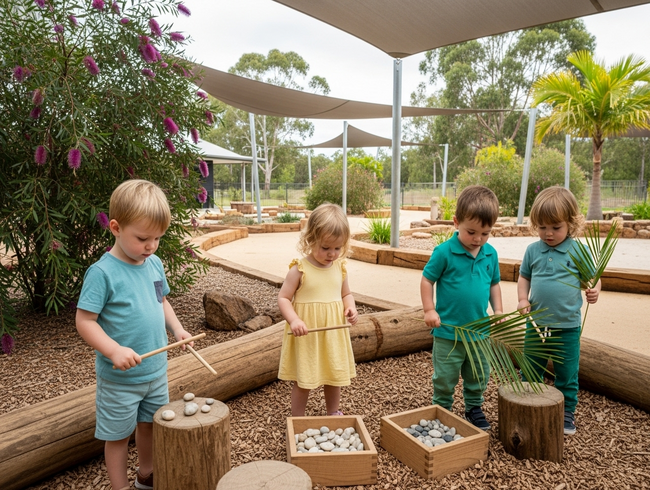
Our philosophy recognises that toddlers learn best when they can move freely between structured activities and spontaneous exploration. We provide materials and opportunities for music and movement throughout our spaces, allowing children to engage with rhythm, melody, and movement as naturally as they breathe.
Our educators are trained in developmental approaches that support individual learning styles while fostering group experiences that build social skills and emotional intelligence. We understand that each child’s journey with music and movement is unique, and we honor that individuality while providing rich, varied experiences.
Supporting Music and Movement Learning at Home
The benefits of music and movement extend far beyond formal learning environments. Here are ways parents can incorporate these powerful experiences into daily routines:
Daily Integration Strategies
- Wake-Up Dancing: Start mornings with gentle music and stretching
- Cleanup Songs: Use rhythmic songs to make tidying fun and efficient
- Cooking Rhythms: Let toddlers help create rhythms while cooking or baking
- Nature Sounds: Explore outdoor music-making with natural materials
- Bedtime Winddown: Use soft, slow music and gentle movement for calming routines
Building a Music and Movement Toolkit
You don’t need expensive instruments to create rich musical experiences. Consider these affordable options:
- Wooden spoons and various containers for drumming
- Shakers made from sealed containers with rice or beans
- Scarves, ribbons, or lightweight fabric for dancing
- Simple bells or chimes for gentle sounds
- Natural materials like sticks, stones, and shells for outdoor music-making
Measuring Progress and Development
While formal assessment isn’t necessary for toddler music and movement activities, observing certain developmental markers can help parents and educators understand a child’s growth:
Developmental Milestones to Observe
- 12-18 months: Bouncing to music, simple imitation of movements, exploration of sound-making objects
- 18-24 months: Dancing with more coordinated movements, following simple musical directions, creating intentional sounds
- 24-36 months: Moving to different rhythms, participating in group activities, expressing preferences for certain songs or activities
Remember that development occurs at different rates, and the goal is always joyful engagement rather than performance perfection.
The Long-Term Impact of Early Music and Movement
Research consistently shows that children who participate in quality music and movement experiences during their toddler years demonstrate advantages that extend well into their school years and beyond:
- Enhanced Reading Readiness: Musical experiences strengthen phonological awareness, a key predictor of reading success
- Mathematical Thinking: Pattern recognition and rhythm support later mathematical concepts
- Social-Emotional Skills: Group musical activities build empathy, cooperation, and emotional regulation
- Physical Confidence: Regular movement experiences develop body awareness and physical competence
- Creative Expression: Early exposure to music and movement fosters lifelong appreciation for the arts
These benefits highlight why investing in quality music and movement experiences during the toddler years creates such powerful foundations for lifelong learning and wellbeing.
Dancing Toward Bright Futures
Music and movement activities for toddlers represent far more than entertainment – they are fundamental building blocks for healthy brain development, physical growth, and emotional intelligence. When we provide young children with rich, varied opportunities to move, create, and express themselves through music, we are literally helping to build the neural foundations that will support their learning for years to come.
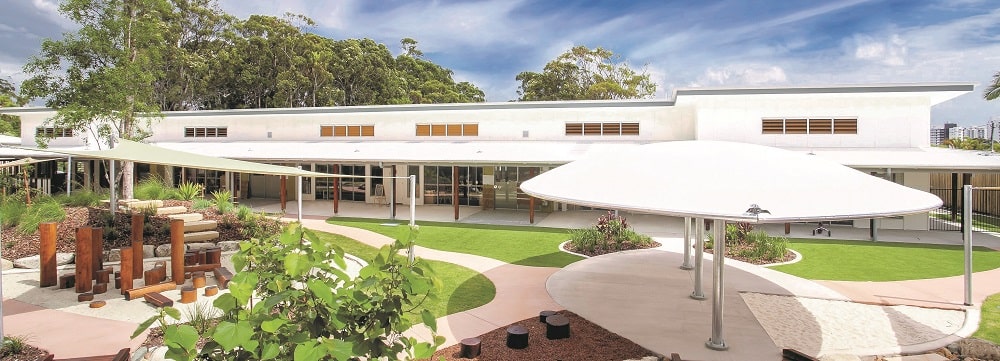
At Okinja Early Learning Centre, we’ve seen countless toddlers discover their voices, their bodies, and their capacity for joy through music and movement. These experiences create not just immediate happiness, but lasting neural pathways that support confident, creative, and capable learners.
Whether you’re a parent looking to enrich your home environment or an educator seeking to enhance your program, remember that the most important ingredient in any music and movement activity is joy. When children experience the pure delight of moving their bodies to rhythm, creating sounds, and sharing these experiences with caring adults, they are receiving one of the greatest gifts we can offer – the foundation for a lifetime of learning, creativity, and connection.
The rhythm of learning begins early, and every dance step, every clapped rhythm, and every joyful song contributes to the magnificent symphony of a developing mind. Contact us today to schedule a tour and discover how our research-backed programs can accelerate your toddler’s development through the joyful power of music. Let the music begin!

